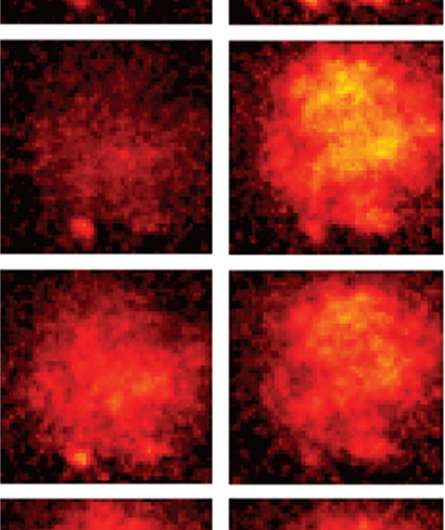November 20, 2015 report
New tool offers unprecedented insight into brain electrical activity

(Medical Xpress)—A team of researchers at Stanford University has announced the development of a new tool that they claim will offer unprecedented insight into the actions of neurons inside a living creature. In their paper published in the journal Science the team outlines how the tool works and how they believe it might be used with future research efforts. Emily Underwood, a staff writer with the journal, offers an 'In Depth' piece on the work done by the team in same issue.
To better understand how the brain works, scientists would ideally be able to watch in real time as neurons fire and then as those electrical signals make their way through the neural network and interact with other neurons. Making this happen, would of course mean creating tools that are able to offer a way to view brain activity in a living organism. Thus far, such efforts have met with limited success, due, as Underwood points out, to techniques that are too slow or are so limited in scope that they do not offer much in the way of meaningful information. In this new effort, the researchers describe a new tool they have developed that allows for actually watching as neurons spike—in awake mice and flies—a new type of genetically encoded voltage indicator.
The tool is an improvement on earlier neuron membrane voltage indicators because it is both faster and brighter—to make it, they fused a molecule that was known to be extremely sensitive to voltage applied to its membrane, with a protein that fluoresces when voltage is applied. Then, they adapted a type of virus to deliver the molecule to a neuron. The tool works by rendering spikes of neural electrical activity that when viewed under a microscope, appear as flashes of light. The team reports that the tool is capable of highlighting the action of neurons to less than one millisecond, and that their approach reduced the rate of false readings to nearly zero.
The tool allows researchers to view brain processing in living animals and represents a significant breakthrough in neural science—at the higher speeds, future researchers will have a chance to watch characteristics of neural activity that have never been seen before—all in real time.
More information: High-speed recording of neural spikes in awake mice and flies with a fluorescent voltage sensor, Science DOI: 10.1126/science.aab0810
ABSTRACT
Genetically encoded voltage indicators (GEVIs) are a promising technology for fluorescence readout of millisecond-scale neuronal dynamics. Prior GEVIs had insufficient signaling speed and dynamic range to resolve action potentials in live animals. We coupled fast voltage-sensing domains from a rhodopsin protein to bright fluorophores via resonance energy transfer. The resulting GEVIs are sufficiently bright and fast to report neuronal action potentials and membrane voltage dynamics in awake mice and flies, resolving fast spike trains with 0.2-millisecond timing precision at spike detection error rates orders of magnitude better than prior GEVIs. In vivo imaging revealed sensory-evoked responses, including somatic spiking, dendritic dynamics, and intracellular voltage propagation. These results empower in vivo optical studies of neuronal electrophysiology and coding and motivate further advancements in high-speed microscopy.
© 2015 Medical Xpress


















